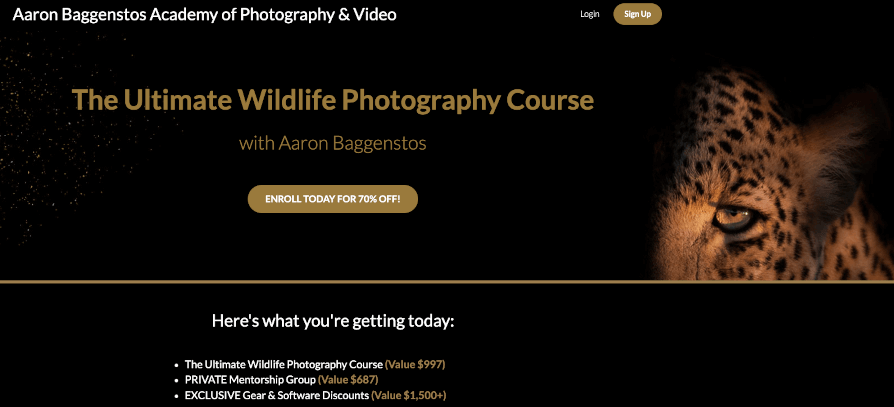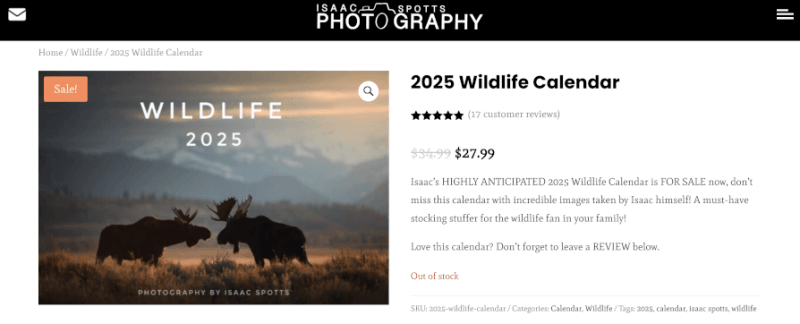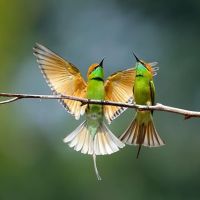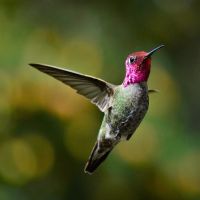Wildlife photography is one of the most rewarding genres to pursue, but turning your stunning images into a reliable income requires strategic planning and diversification. While the market is competitive, photographers who understand how to market their work across multiple channels can build sustainable businesses around their passion for capturing nature.
Utilising proven pathways to monetize your wildlife photography, you can replicate the success of some of the most profitable nature photographers by adapting to a changing marketplace. The photographers who thrive aren’t just talented behind the camera but savvy about creating multiple revenue streams that work together.
Whether you’re just thinking about your next side hustle or want tips to spark more sales for your existing photography business, these actionable strategies will help you reach the right buyers and increase the value of your images.
Maximize your revenue and build your professional wildlife photography business career using this guide!
1. Understand the Wildlife Photography Market
The wildlife photography market is highly competitive and saturated with talent, from hobbyists with professional gear to seasoned experts. However, the key to surviving in this space is not just knowing how to take great wildlife photos, but also knowing where to sell them and how to diversify your income streams.
There are mediocre wildlife photographers who are great marketers and therefore are quite successful. Conversely, there are great photographers who are struggling to get noticed because they don’t know how to handle the marketing side of things.
– Sean Crane in his Shutterbug interview.
Success in this field requires developing both your photographic skills and business acumen. The most prosperous wildlife photographers combine unique visual perspectives with strategic marketing and multiple revenue streams.
I feel very lucky that I can focus on wildlife full time. But to do so, I need to have several different sources of income. I sell prints on my personal website, do contract work, license my images, write articles for wildlife magazines and I have my safari company.
– Daniel Dietrich in his Shutterbug interview.
2. Sell to Publications: Magazines, Books, Calendars, and Advertising
Publications remain one of the most established channels to sell your work and build credibility. While the digital transformation has changed the publishing landscape, many prestigious outlets still pay well for exceptional wildlife imagery. Learning how to sell wildlife photos to magazines starts with researching each publication’s specific requirements and audience.
Magazine Submissions
Major wildlife publications like BBC Wildlife and National Geographic have specific submission guidelines that must be followed carefully. BBC Wildlife considers both individual images and photo stories, making it suitable for photographers with varying portfolio depths.

When approaching these publications, research their visual style and audience first. Before submitting, always check the publication’s current guidelines on their website, as requirements frequently change.

Payment rates vary significantly based on magazine circulation and image placement. According to Jad Davenport, top-tier magazines (with circulation over 500,000) typically pay between $600-1,000 per day for assignment work, or $600 for a full-page image when purchasing stock photos. Smaller publications might offer $150-350 per image, while niche magazines could pay $50-200 for a package of photographs.
Rights-Managed Licensing
There are two main licensing approaches in wildlife photography: rights-managed and royalty-free.
With rights-managed licensing, a contract system where you grant specific, limited permissions to a buyer, you typically earn higher payments per individual sale, but may sell fewer images overall.
Meanwhile, royalty-free licensing allows buyers to pay once and use the image multiple times across various projects without additional fees. Many buyers prefer royalty-free for its flexibility, though each sale generally brings in less revenue than a rights-managed license.
The following examples reflect typical rights-managed licensing fees that wildlife photographers might expect to receive. These rates vary based on factors such as image quality, exclusivity, circulation size, and your reputation in the industry.
Editorial use (magazines, newspapers):
- Quarter page: $150-250.
- Half page: $250-350.
- Full page: $400-600.
- Cover: $800-1,500.
These prices will vary depending on the status and size of the magazine publication.
Commercial use (advertising, marketing):
- Small business website: $300-500 for one year.
- National advertising campaign: $1,500-5,000+ depending on placement.
- Billboard or large format display: $2,000-4,000 for 3 months.
When selling wildlife photos to magazines and other publications, consider offering exclusive vs. non-exclusive rights. Exclusive rights (where only one client can use your image during a specified period) typically command 50-100% higher fees since you can’t sell that image elsewhere during the license term. Non-exclusive rights allow multiple simultaneous sales of the same image, maximizing your potential revenue across different markets.
For book licensing, negotiate based on print run size, image placement, and whether your photo will appear in promotional materials. Covers and prominent placements in high-circulation publications always command premium rates.
3. Sell Wildlife Photography Prints and Products
Converting your wildlife images into physical products creates a valuable revenue stream that can provide steady income. While the print market is competitive, wildlife photography has distinct advantages as customers connect emotionally with powerful animal images and natural landscapes.
Creating High-Quality Prints
Select images that evoke emotion or tell compelling stories – mother-baby interactions, dramatic silhouettes, and endangered species typically perform well as prints that customers want to display in their homes. Invest in professional-grade printing with archival papers and inks. Semi-gloss or pearl finishes often work best as they enhance color vibrancy while minimizing glare.
Strategic Pricing for Wildlife Prints
One of the most effective approaches for wildlife photographers is implementing a tiered pricing strategy. By offering your prints at multiple price points, you can appeal to different buyer segments and maximize revenue potential from each image in your portfolio.
Your strategy could look like:
- Discovery Tier ($50-150): Smaller open-edition prints that make your work accessible to casual admirers and first-time buyers.
- Enthusiast Tier ($200-500): Medium-sized prints in limited editions, each hand-signed to add personalization and uniqueness.
- Collector Tier ($600-2,000+): Larger format limited-edition prints with certificates of authenticity and premium presentation.
- Legacy Tier ($2,000+): Museum-quality presentations in highly limited quantities (5-10 prints) for serious collectors.
This structured approach helps customers understand the value differences between options while creating a sense of exclusivity around your best work. When setting prices, look beyond basic production costs to consider what truly makes each image valuable – the rarity of the wildlife encounter, the technical challenges you overcame to capture it, and its artistic and emotional impact.
Conservation Storytelling as Added Value
Wildlife prints become more valuable when they tell a conservation story. Include informational cards with your prints that explain the species’ conservation status, ecological importance, or the challenges they face. This approach transforms a decorative piece into something with deeper meaning and educational value.
For endangered species in particular, providing context about protection efforts or habitat loss creates an emotional connection that justifies premium pricing. As an example, bird photography collectors often seek images of rare species or remarkable behaviors, making it important to understand how to sell bird photography to this dedicated niche. Avian enthusiasts especially appreciate details about migration patterns, population trends, and conservation efforts.
Many buyers specifically seek wildlife art that aligns with their environmental values, making conservation messaging both ethically sound and commercially strategic.
The majority of my clients are looking for fine art pieces to decorate walls.
— Bev Pettit in his Shutterbug interview.
These clients value both aesthetic quality and the authentic stories behind the images, making conservation-focused presentation a powerful differentiator in a competitive market.
Diversify Your Product Offerings
Expand beyond traditional wall prints with products like:
- Calendars featuring seasonal wildlife.
- Postcards showcasing local species.
- Photo books organized around conservation themes.
These derivative products can reach different market segments while building your photography brand with customers who might not purchase large prints but still appreciate your work.
4. Sell Your Wildlife Photography to Stock Image Agencies
Selling your wildlife photography through specialized stock agencies provides steady passive income while you focus on other creative projects. Choosing the right agencies is crucial for maximizing both earnings and exposure.
Specialized Wildlife Stock Agencies
For wildlife photography, specialized agencies typically offer better rates and more targeted exposure than general stock sites:
- Minden Pictures: Recognized as the foremost provider of wildlife and nature stock photography for publishing and advertising professionals, representing award-winning photographers.
- Nature Picture Library: A professional platform that donates a portion of their quarterly profits to conservation organizations, adding ethical value to your work.

- Nature in Stock: Connects photographers with editorial and commercial clients seeking nature imagery for various media uses.
- Animals Animals: Specializes exclusively in animal imagery, ideal for wildlife photographers focused on fauna.
Professional wildlife photographers generally avoid mass-market royalty-free platforms like Shutterstock and iStock, as these often devalue specialized wildlife imagery with low payment rates.
Optimizing Your Stock Submissions
- Keyword strategy: Include scientific names, behaviors, locations, and seasonal information to improve searchability.
- Focus on marketable subjects: Agencies particularly value rare species, unusual behaviors, and conservation stories.
- Maintain technical excellence: Submit only your sharpest, cleanest, and most compelling compositions.
- Build a diverse portfolio: Include variations of successful images showing different angles and behaviors.
Considerations Around Licensing Contracts
Rights-managed licensing gives you control over image usage while royalty-free allows buyers unlimited use after a single payment.
Reserve rights-managed licensing for your most valuable shots:
- Rare species or behavior captures.
- Images with exceptional emotional impact.
- Photos with conservation significance.
- Endangered species documentation.
These unique images can command premium prices in the marketplace.
Consider royalty-free licensing for:
- Common wildlife in standard poses.
- Multiple similar shots from the same session.
- Habitat or contextual images with broader application.
Do not hesitate to use both approaches – leveraging rights-managed for exceptional images while offering more standard shots through royalty-free channels. This hybrid strategy helps maximize overall revenue by balancing higher per-image fees with the volume potential of royalty-free sales.
5. Participate in Photo Competitions
Entering wildlife photography competitions can boost your reputation and provide valuable income through prizes. These contests offer exposure to global audiences and validation of your work from industry professionals.
Prestigious Wildlife Photography Competitions
Several major competitions offer substantial prize money and career-enhancing recognition:
- BigPicture Natural World Photography Competition: Offers a $5,000 grand prize and $1,000 for each category winner, with exhibition at the California Academy of Sciences.
- Nature Photographer of the Year: A premier European competition with a total prize pool of €25,000.
- National Wildlife Photo Contest: Run by the National Wildlife Federation, with $5,000 for the grand prize winner and $500 for category winners.
- Comedy Wildlife Photography Awards: Rewards humorous wildlife moments with photography equipment and a safari in Kenya for two people.

Preparing Winning Entries
To maximize your chances of success:
- Study previous winners: Analyze past winning images to understand what judges value in each competition.
- Target your submissions: Select images that align with each contest’s specific focus and aesthetic preferences.
- Perfect your technical execution: Ensure impeccable sharpness, exposure, and composition – judges typically eliminate technically flawed images first.
- Tell compelling stories: Images that combine technical excellence with emotional impact or conservation narratives perform best.
Even if you don’t win, the process of preparing and submitting work helps refine your portfolio and develops your critical eye.
6. Create and Sell Educational Content
Wildlife photography education offers significant income opportunities that complement your creative work. Your expertise can generate substantial recurring revenue through various formats, transforming your knowledge into a profitable business asset.
Educational Formats and Pricing
- Online Courses: Create scalable income with minimal ongoing costs. Structure courses like Aaron Baggenstos‘s Ultimate Wildlife Photography Course, with pricing from $55-170 for specialized topics to $170-1000 for comprehensive masterclasses.

- In-person Workshops: Command premium fees ($300-1,000 for single-day experiences, $1,500-7,000 for multi-day intensives) while creating deeper connections with participants. As an example, Pangolin Photo Safaris offers various workshops in Africa, with prices starting from $4,995 for a 7-day experience.
- Photo Tours and Safaris: Offer high-ticket experiences ($4,500-15,000) combining immersive travel with specialized photography instruction, similar to Iceland Photo Tours‘ Namibia Wildlife Photography Tour.
- Mentorship Programs: Like Steve Winter with Zoom Photo Tours, provide personalized instruction at premium rates ($300-500 monthly or $1,000-3,000 for multi-month programs).
Strategic Pricing Structure
Implement tiered pricing to maximize revenue:
- Starter: Basic access at $97-197.
- Standard: Enhanced features and community access at $297-497.
- Premium: Personalized feedback and exclusive content at $697-997.
For exclusive workshops, limit participation to create scarcity value. For example, the Secret Swamps Workshop, restricts attendance to just four photographers, commanding $3,000-4,000 per person.
Effective Marketing Approaches
Build demand by first sharing free content that demonstrates your teaching style, then develop an email list featuring wildlife photography tips. Show student progress through before/after examples, collect testimonials from past participants, and partner with wildlife organizations for extended reach.
To be successful, combine technical instruction with conservation awareness, creating experiences that inspire both photographic skill and environmental stewardship.
7. Build Your Brand and Online Presence
A strong personal brand and strategic online presence are essential for monetizing your wildlife photography. Knowing where to sell wildlife photos starts with establishing your unique identity in the marketplace.
Platform Strategy
- Instagram: Showcase visual impact with consistent posting (3-5 times weekly) using wildlife-specific hashtags to reach enthusiast communities.
- YouTube: Create behind-the-scenes content showing field techniques and wildlife encounters to demonstrate expertise and build authority.
- LinkedIn: Connect with commercial clients, publications, and conservation organizations by sharing professional achievements and industry insights.
- Email marketing: Build a direct channel to your audience with compelling opt-in incentives like free guides. With an average ROI of $42 for every $1 spent, email marketing outperforms social platforms for direct sales.
Monetizing Your Audience
Convert followers into customers through:
- Community Membership: Offer tiered access ($5-30 monthly) to exclusive content through platforms like Patreon.
- Affiliate partnerships: Earn commissions by recommending camera equipment, travel gear, and accessories you genuinely use.
- Sponsored content: Negotiate paid partnerships with conservation organizations and outdoor brands once you reach 10,000+ followers.
- Content licensing: Make your popular social media images available for commercial use through simplified licensing options.
Developing Your Personal Branding
Create a distinctive brand like National Geographic photographer Ami Vitale, who connects her wildlife photography to conservation storytelling. Develop a signature visual style through consistent editing and composition techniques, link your work to meaningful causes, share your personal journey, and maintain ethical standards in all partnerships.

A cohesive brand identity across all platforms helps buyers recognize your work instantly and builds the trust necessary for premium sales.
8. Create a Professional Photography Website
While social media platforms are valuable for building an audience, a dedicated photography website serves as your primary business hub and portfolio showcase.
You should have your own site; something that’s yours and yours alone, so that when you send a link to a buyer, they get to see and know you and your work in a manner that’s unique to you.
– Gary Crabbe for Shutterbug.
Essential Website Elements for Wildlife Photographers
Your website should include these key components:
- Strategic Portfolio Organization: Arrange your wildlife photography by species, habitats, or conservation stories rather than chronologically. Feature your strongest images first and last in each gallery to create a memorable impression.
- Conservation Storytelling Sections: Create dedicated pages that connect your images to conservation narratives, adding depth beyond the visual impact.
- Print Store Integration: Implement a secure eCommerce system that protects your images while showcasing various print options. Quality plugins can help with watermarking, right-click protection, and secure checkout.
- Authentic About Page: Share your unique journey and connection to wildlife photography. This personal narrative helps potential clients connect with your work on a deeper level.
- Clear Licensing Information: Include well-defined usage terms and pricing tiers for commercial clients seeking to license your images.
Technical Considerations
Choose a website platform that offers:
- Mobile-responsive design that adapts to all screen sizes.
- Fast loading speeds, especially for high-resolution wildlife images.
- SEO-friendly structure to improve visibility in search results.
- Gallery functionality with image protection features.
- eCommerce capabilities if selling prints directly.
Your website serves as both portfolio and business hub – a space where you control the presentation, and monetization of your work without algorithm limitations. Unlike social platforms, a professional website signals credibility to potential clients, publications, and commercial partners looking to work with established wildlife photographers.
⚠️ While you gain creative control, optimizing for search engines remains essential. Use descriptive image filenames, add relevant alt text, create content answering common questions about wildlife photography, and ensure fast loading speeds. This strategic approach helps potential buyers discover your work when searching for wildlife images to purchase.
Utilizing your own website to sell wildlife photography provides direct control over your brand, portfolio presentation, and pricing strategy. It eliminates the need for external publishers, empowering photographers to establish a unique online presence, retain a higher percentage of sales, and build a direct relationship with their audience, fostering trust and credibility.
– Tam Vincent, Content Manager.
Selling Your Photography Online
Integrating eCommerce functionality into your wildlife photography website allows you to sell prints directly to customers without relying on third-party platforms that take commissions. Modern eCommerce solutions like WooCommerce make this process accessible even for photographers without technical expertise.
Image Protection Strategies
When selling wildlife images online, protecting your work from theft is essential. Implement these proven methods:
- Automated watermarking: Use plugins like FooGallery that automatically add watermarks to all uploaded images WooCommerce. Position your watermark strategically in areas difficult to crop out.
- Disable right-clicking: Install plugins that prevent the standard right-click download option. While not foolproof, this deters casual theft.
- Low-resolution previews: Display smaller, lower-resolution versions of your images online while delivering high-resolution files only to paying customers.
- Metadata embedding: Include your copyright information and contact details in each image’s metadata, which remains even if watermarks are removed.
eCommerce Functionality for Wildlife Photographers
Your online store should include these key elements:
- Print size variations: Offer multiple print sizes and formats with appropriate pricing for each.
- Limited edition options: Create scarcity with numbered editions at premium prices.
- Digital licensing options: Include commercial usage rights at various price points.
- Secure payment processing: Implement trusted payment gateways like Stripe or PayPal.
When configuring your product pages, include compelling descriptions that tell the stories behind your wildlife images. These narratives add value beyond the visual impact and justify premium pricing for your work.
9. Explore Alternative Income Streams
Successful wildlife photographers maintain multiple revenue sources to create a sustainable business. Beyond core strategies like print sales and stock photography, these additional income streams can stabilize your finances and expand your reach.
Brand Partnerships and Sponsorships
Equipment manufacturers, outdoor clothing brands, and travel companies actively seek wildlife photographers for promotional partnerships. These arrangements range from one-off projects to long-term relationships, compensated through payment, gear, or both.
When pursuing sponsorships:
- Create a focused pitch highlighting your unique perspective and audience engagement.
- Target companies whose conservation values align with your own.
- Look beyond camera manufacturers to less saturated opportunities like outdoor apparel or eco-tourism brands.
Affiliate Marketing Opportunities
Generate passive income by recommending products you genuinely use in your wildlife photography. Through affiliate programs like Amazon Associates and Adobe’s Affiliate Program, you earn commissions on purchases made through your links. Focus on photography gear and specialized wildlife equipment relevant to your audience.
Speaking Engagements and Presentations
Your field experiences and technical expertise are valuable to camera clubs, conservation organizations, and corporate events seeking inspirational content. Speaking fees typically range from $250-500 for local talks to $1,000+ for major events, with opportunities to generate additional income through print sales to attendees.
Merchandise Development
Transform your popular wildlife images into products beyond traditional prints:
- Premium calendars featuring seasonal wildlife.
- Conservation-focused greeting cards.
- Coffee table books on specific species or habitats.

These products can be produced through print-on-demand services to minimize upfront investment while expanding your revenue streams.
10. Pricing Your Wildlife Photography Effectively
Effective pricing is the foundation of a sustainable wildlife photography business, regardless of which monetization channels you pursue.
Research is essential to understanding your images’ market value. Study what similar photos sell for, connect with fellow photographers, and analyze rates from publications and stock agencies that specialize in nature imagery.
As wildlife photographer Gary Crabbe advises “If you don’t value your work, no one else will.” This mindset establishes your professional standing in the marketplace.
When developing your pricing structure, consider these key factors:
- Image uniqueness: Rare wildlife encounters command higher prices.
- Usage rights: Exclusive licensing deserves 50-100% more than non-exclusive rights.
- Production costs: Factor in equipment, travel expenses, and time spent.
- Market segment: Advertising clients can pay more than small publications.
Always factor in overhead costs to ensure your pricing provides a sustainable profit margin while remaining competitive.
11. Building Your Wildlife Photography Career
Developing a successful wildlife photography career requires strategic planning and persistence. Whether beginning as a hobbyist or transitioning to full-time work, start by building a focused portfolio that showcases your unique perspective.
Rather than photographing everything, develop expertise in specific subjects – perhaps backlit birds in flight or intimate primate portraits. This specialization helps establish your reputation and answers the crucial question of how to sell bird photography or other wildlife niches effectively.
Networking accelerates professional growth. Join communities like Nature Photographers Network or Wildlife Photographers United, attend industry events such as the North American Nature Photography Association (NANPA) Summit and connect with conservation organizations that need visual content. These relationships often lead to unexpected opportunities and insider knowledge about where to sell wildlife photos for premium rates.
You can start working as a wildlife photographer part-time while maintaining other income. This approach provides stability while you build your reputation and client base. Gradually expand your revenue streams – perhaps starting with stock photography, then adding print sales and workshops as your expertise grows.
Set yourself apart by developing technical innovations, specialized knowledge of rarely photographed species, or mastery of challenging environments. These distinctive capabilities create unique selling points that clients and publishers value enough to pay premium rates for, establishing you as an authority in an increasingly competitive field.
Build Your Wildlife Photography Website with FooGallery to Maximize Sales
To effectively sell your wildlife photography online, you need a professional platform that showcases your work while protecting your intellectual property. FooGallery, an easy-to-use WordPress gallery plugin, provides wildlife photographers with specialized tools designed to transform your images into a profitable business.
This powerful gallery plugin offers image protection features that address a critical concern for wildlife photographers who’ve invested time and resources capturing unique moments. The automated watermarking system and right-click prevention safeguard your valuable shots from unauthorized use while still presenting them beautifully to potential buyers.
Visual presentation matters tremendously when selling wildlife photography. FooGallery’s professional display options offer responsive layouts that adapt to any screen size, ensuring your dramatic wildlife moments look impressive whether viewed on desktop or mobile. The filtering and organization tools allow visitors to easily browse by species, location, or behavior – perfect for wildlife photographers with extensive collections.

Converting interest into sales requires seamless eCommerce integration. FooGallery works perfectly with WooCommerce, enabling you to sell prints, digital downloads, or photo packages directly from your website without complex technical setup. This optimized purchase process significantly improves conversion rates for photographers.

Images courtesy of Pixabay
I looked at all the galleries when I was building my new photography site. I wanted one that was elegant looking on all platforms and let me tell a story for every photo. Foo was the best.
Carla
With FooGallery, you can create a professional wildlife photography store that combines portfolio presentation with eCommerce functionality – the perfect foundation for implementing all the monetization strategies covered in this guide.
Ready to start monetizing your wildlife photography portfolio? Get FooGallery today and build a professional online gallery that protects your work, impresses visitors, and converts them into customers – all with just a few clicks.
Start exploring which of these sales opportunities are best suited to you! And don’t forget to check out FooGallery as an excellent solution for creating a photography website as the foundation of your wildlife photography sales.
The Best WordPress Gallery Plugin
FooGallery is an easy-to-use WordPress gallery plugin, with stunning gallery layouts and a focus on speed and SEO.





